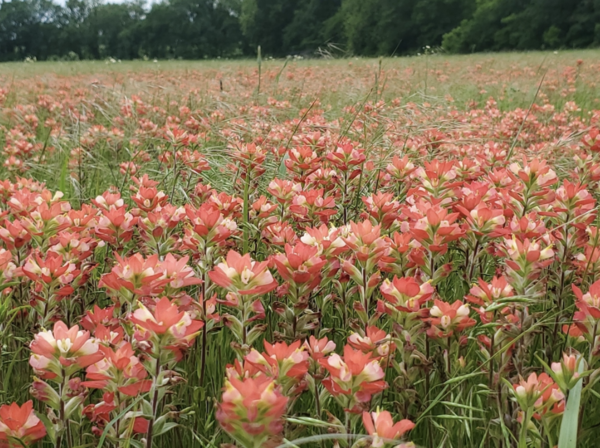In the wild expanse of nature, there exists a plant that seems to paint the earth with fiery strokes of color. This plant is known as Castilleja coccinea, or more commonly, the Flame Azalea. With its brilliant red blooms that appear as though they've been touched by a painter's brush, it’s no wonder this beauty has earned several names over the years: Red Flowered Castilleja, Red Vervain, and most notably, the "Scarlet Indian Paintbrush." In every sense, it is a vibrant splash of life in the tapestry of the natural world, captivating the imagination of those fortunate enough to encounter it.

The Flame Azalea doesn’t bloom like typical flowers. Instead of soft petals, it showcases clusters of striking, flame-like bracts that surround the true, smaller flowers. These bracts, often a vivid crimson or scarlet, resemble fiery tongues licking the sky, giving the plant its iconic “flame” look. From a distance, these fiery blooms seem almost unreal, as though painted by a wild artist who had no need for moderation. The colors are bold—red, orange, and sometimes yellow—each bract a separate stroke of brilliance, each angle catching the light differently. This vibrant display earned it the name "Indian Paintbrush"—for it feels like a vivid, colorful paintbrush has swept across the landscape, leaving behind a trail of burning red.

But the Flame Azalea is more than just a pretty face. This plant is a true survivor, thriving in environments that might challenge more delicate species. It favors areas that are sunny with well-drained soil, often popping up in prairies, meadows, and forest edges. Though it flourishes in the open, it’s resilient enough to handle the harsh conditions of late summer, when the sun is at its hottest and the land thirsts for rain. It’s the kind of plant that survives and even thrives under the pressure of competition, its roots often parasitizing the roots of neighboring plants to obtain the nutrients it needs to keep burning bright.
The Flame Azalea is also a semi-parasitic plant, meaning it doesn't rely solely on the soil for nutrients. Instead, it taps into the root systems of nearby plants, drawing from their wealth to fuel its own growth. This "half-parasitic" relationship gives it a certain resilience, making it a formidable presence in the landscape, even in less-than-ideal conditions. Like its fiery blooms, it burns with determination, refusing to be overshadowed by the challenges of its environment.

What’s perhaps most striking about the Flame Azalea is its ever-shifting palette. The most common color is a rich, deep scarlet, but depending on the location and environmental factors, its flowers can range from orange to even a soft yellow. The hues seem to change with the light, sometimes glowing bright as if lit from within, and other times, taking on a more subdued warmth. These color shifts make the Flame Azalea feel alive in a way that few plants do, as though it’s not just a part of nature, but an active participant in the landscape's ever-changing masterpiece.

The name “Indian Paintbrush” perfectly captures this sense of creative, fiery expression. It evokes the image of a painter, dipping their brush in a palette of the most vivid reds and oranges, then letting the strokes fly across the canvas of the wild. The result is a piece of living art, one that bursts with life and energy, impossible to ignore.

The Flame Azalea has more than just aesthetic appeal—it also carries deep symbolic meaning in many cultures. In Native American traditions, plants like the Indian Paintbrush are often seen as symbols of strength, passion, and vitality. The vivid colors represent the power of nature and the burning spirit of life itself. It’s a reminder that beauty is not only in what is delicate and refined but also in the wild, untamed aspects of the world. The Flame Azalea, with its bold color and tenacious spirit, embodies this idea perfectly.

This plant’s wild beauty is mirrored in its interactions with humans. Beyond its place in folklore and symbolism, it has become a beloved subject for gardeners and nature enthusiasts alike. While it’s native to parts of North America, especially in the Eastern United States, its striking appearance has made it a sought-after ornamental plant. People cultivate it not just for its beauty, but for the way it can light up any garden, adding a touch of the wild to cultivated spaces. Whether it's found in the wild or carefully tended in a garden, the Flame Azalea’s brilliance is undeniable.

In the vast landscape of nature, the Flame Azalea stands out like a flickering flame, painting the world with vivid reds, oranges, and yellows. It’s a living testament to the power of color, the resilience of nature, and the untamed beauty that can arise from the most unlikely places. Whether you see it as an "Indian Paintbrush" or simply as a symbol of fire and spirit, the Castilleja coccinea has a way of capturing your attention and stirring something deep within. It reminds us that, sometimes, nature is not content with being simply beautiful—it insists on being bold, on setting the world ablaze with the fire of life.
animal tags: Flame-Azalea
We created this article in conjunction with AI technology, then made sure it was fact-checked and edited by a Animals Top editor.